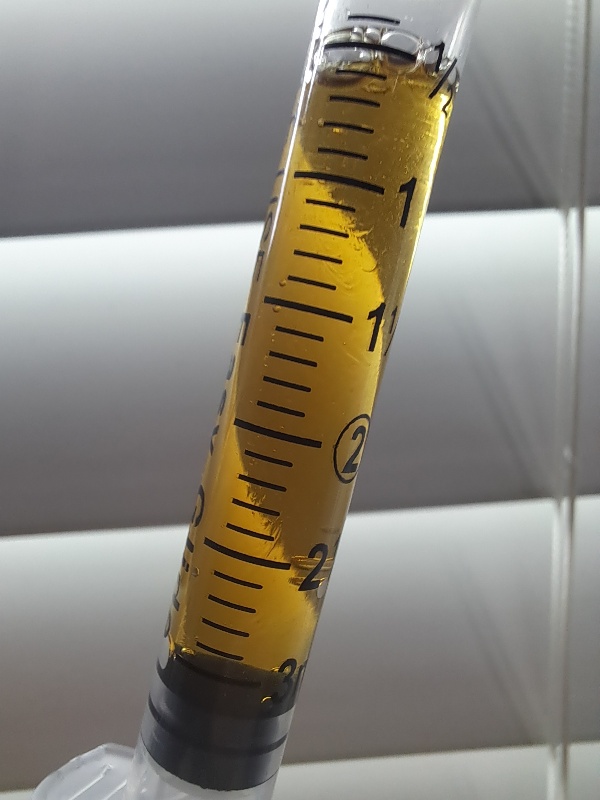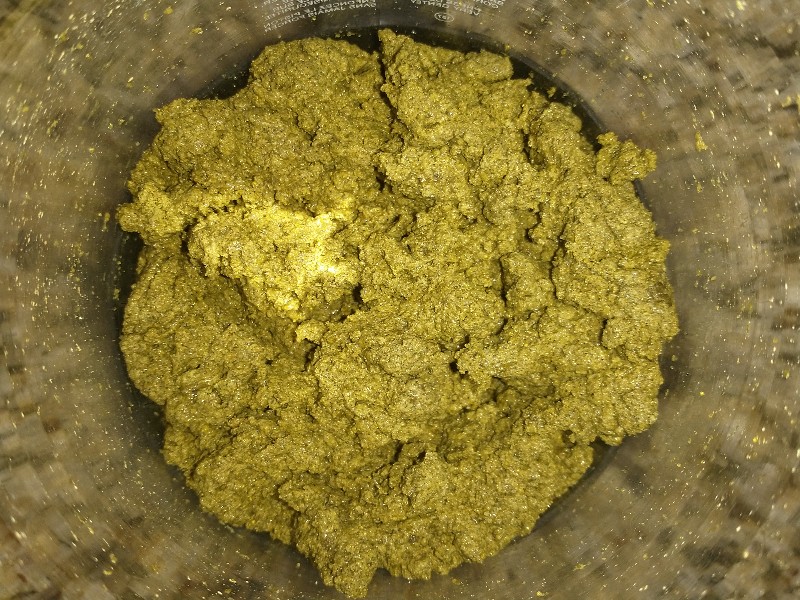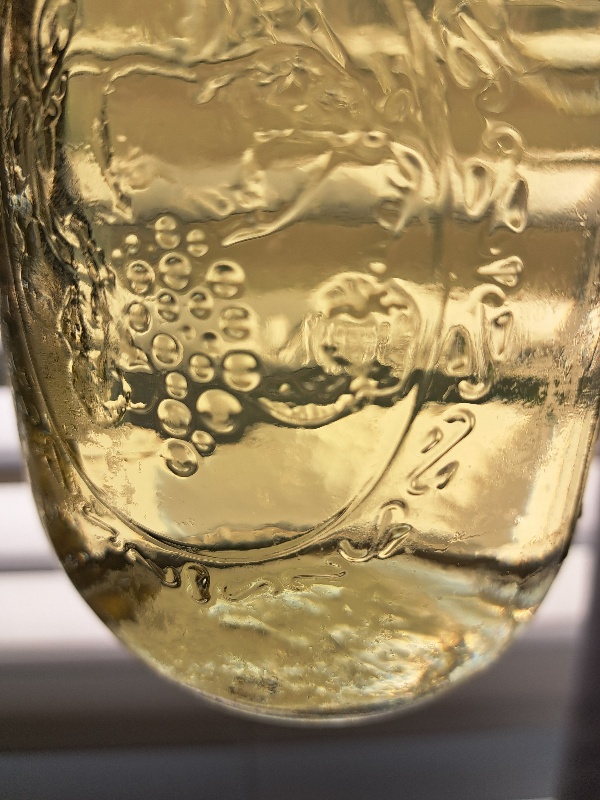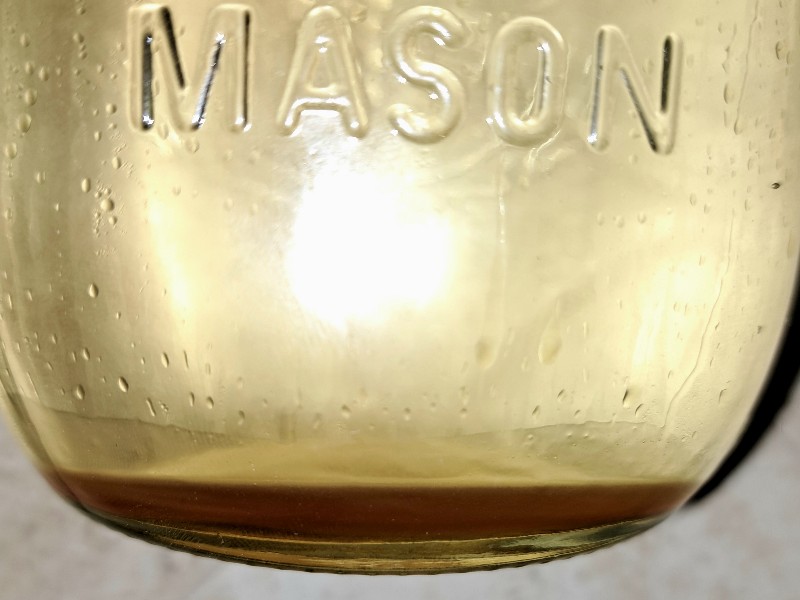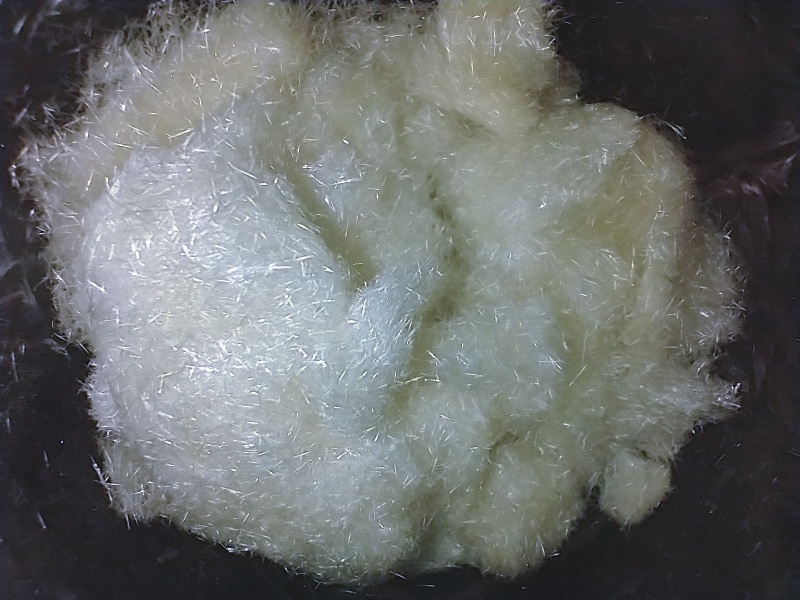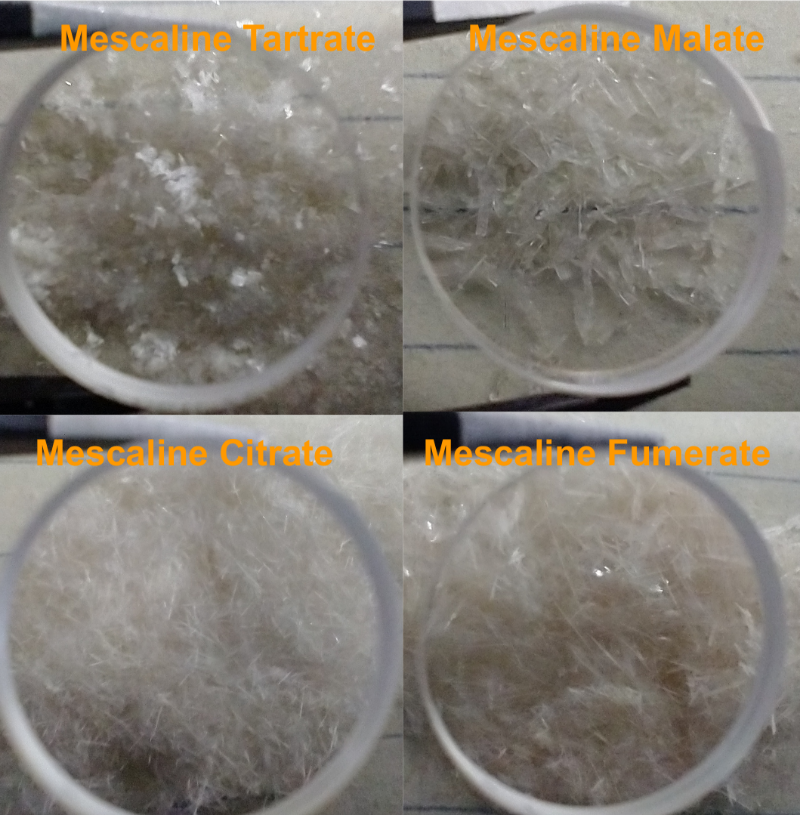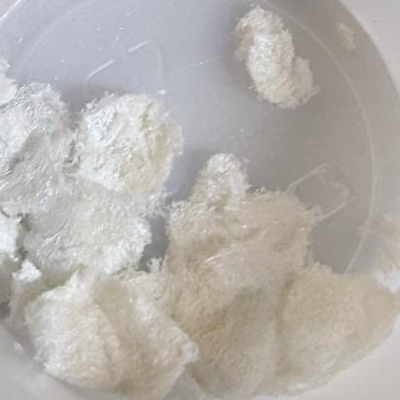HIELO
Contents
Introduction 🙏
HIELO stands for Honey In Ethyl-acetate Laizily Over-the-counter. In this process, DMT from MHRB is precipitated in ethyl acetate as relatively pure monomescaline citrate hydrate honey. The hydration number (number of water molecules) is currently unkown. The honey is dissolved in 50/50 PG/VG to make a dmt salt e-juice (see Fig. 1). This technique (TEK) is specialized for MHRB, is relatively simple, and avoids harsh chemicals.
Thanks to everyone who contributed to this process: _Trip_, Loveall, and others.
Safety ⛑️
Review ethyl acetate[1] and citric acid[2] safety information. Verify solvent MSDS, plastic compatibility, and clean evaporation.
This TEK is food safe if food grade materials are used.
The final product is a dmt salt e-juice. However, other plant material could be present and/or some of the extraction ingredients could be in the product depending on technique or possible process errors. The long term health effects of vaping this product are unknown and therefore carry a risk. It is up to each sovereign individual how to proceed. Do not share this product without explaining these risks and absolutely never sell it.
Following this advice does not guarantee safety. It is up to each adult individual to make their own personal decisions.
Materials🛒
Consumables👩🌾
- 150g water
- 25g Ca(OH)2 (lime)
- 100g finely ground MHRB†
- 1qt ethyl acetate (sometimes sold as "MEK substitute")††
- 5g of citric acid (~1 tsp)
- Washing soda (Na2CO3) saturated water for solvent reuse
† Ingredients can be scaled down to 5g of cactus powder to perform a TEK test run. This is encouraged for beginners to get a feel for the process before commiting more material.
†† Depending on pull technique using two quarts of ethyl acetate may yield a little more DMT (up to ~+10%). See extraction section for more details.
Equipment🏺
- French press (optional, recommended for extraction)
- kitcjen scale (to measure ingredients)
- Coffee filters, support basket, and funnel
- Quart mason glass jars with lids
- Scale with 0.1g resolution and 500g capacity (to easily measure product)
- Pipette, separatory funnel, or freezer (for solvent reuse water separation)
Process Overview 👀
In short:🟤➠🧑🏾🔬➠🍯➠💉➠💚, where,
- 🟤: Mix MHRB powder to a wet alkaline paste
- 🧑🏾🔬:Pull paste with ethyl acetate and rest/decant
- 🍯: Precipitate DMT honey with citric acid
- 💉: Make e-juice and collect
- 💚: Store ethyl acetate for reuse
Detailed Process 📜
Paste 🟤
Make milky water in a french press, quart jar, or mixing bowl by mixing lime with the rest of the water (~270ml). Mix so there are no lumps of lime. Without giving lime time to settle, gradually add the MHRB powder, stirring thoroughly to ensure the bark is well incorporated. Goal is to get a wet stiff consistency (Fig. 2). If needed gradually add more water as needed.
Extract 🧑🏾🔬
If available, the paste should be in a french press. The french press will make it easy to decant the ethyl acetate. Optionally the paste can be in a a quart jar, but it's not as easy to decant the ethyl acetate. It is possible to have the paste in a mixing bowl, but decanting may be cumbersome.
Cover paste ethyl acetate (~200g) and stir for about 10 minutes. Do not to stir too aggressively as that may cause plant material to absorb excess solvent. A good paste becomes sandy and slightly sticky during extraction and is very easy to handle, but other textures also work. After stirring, rest for two minutes, and decant into a quart jar filtering through a paper coffee filter (do NOT skip or substitute the coffee filter). If using a french press (preferred), only squeeze lightly to accelerate decanting (keeping plastic parts away from the solvent). Squeezing too aggressively can release unwanted water into the extract which will need to be separated in the next step.
If the paste absorbs all or most of the ethyl acetate during the first pull, that's fine. Just add more ethyl acetate, stir, rest, and decant as explained above. Do NOT add water or aggressively manipulate the paste in an attempt to force out the ethyl acetate. Some solvent absorption during the first pull is common.
Repeat the extraction with ~125g of ethyl acetate until the extraction jar is full (5-6 total pulls). A small yield boost can be done by optionally doing more pulls into a second jar. This second jar is also a good check on the effectiveness of the pulls in the main jar the first time this TEK is performed. Poor technique will give a larger yield boost in the second jar, <10% boost is considered good[3].
Rest extract for 24 hours in a refrigerator. Water solubility in ethyl acetate decreases with temperarure, so this cold resting period is effective at removing excess water. Some cloudiness is OK when the EA is cold. If a lot water forms (more than a few droplets forming a visible layer), the paste was either too wet, or the french press squeezing was too aggressive, or the genlte stirring was done with poor technique. Weigh empty jar (0.1g resolution is needed), decant ethyl acetate into it through a coffee filter, cover, and bring to room temperature. Extract will be clear and ready for the next step. The extract needs to be clear, particle free, and without water droplets for the salting process to happen reliably (see Fig. 4).
Precipitate Honey 🍯
Stir ~5 grams (~1 teaspoon) of citric acid powder granules into extract until citric acid dissolves. This should only take a few minutes. Extract should cloud as the citric acid reacts with DMT free base to form mono-DMT citrate which drops out of solution. Leave extract undisturbed. Monomescaline citrate honey should begin to appear after a few hours, and take a few days to complete crash out (3 days is recommended).
Make E-juice 💉
Decant solvent leaving honey behind. Rinse twice with ~ 50ml of fresh ehtyl acetate (this may temporarily dehydrate some of the honey and give it a white color). Allow to air dry until ethyl acetate smell is not present and jar weight stops changing (a few hours at least, one day is reccomended).
Measure jar weight again with 0.1g resilution scale and calculate honey weight (~45% DMT strenght estimated). Add 1.3x of a 50/50 PG/VG solution to the jar and dissolve over a hot water bath to make a dmt salt e-juice of ~20% strenght. There is no analytical data to back up these claims and they could be incorrect.
For example from a 100g of MHRB extraction:
- Empty quart jar weight 388.2g
- Quart jar with DMT citrate honey: 392.6g
- Honey weight 4.6g (equivalent to 2.1g of DMT free base)
- Add 6.0g of 50/50 PG/VG
- Final e-juice product weights 10.6g and contains 2.1g of DMT (~20% strenght) in citrate salt form
Reuse 💚
Reusing solvents is encouraged[4] at the DMT nexus.
Wash spent extract with ~10% sodium carbonate water solution. About 1/3 of the solvent volume is enough for neutralization. Shake vigorously (emulsions do not form). CO2 bubbles may be visible during citric acid neutralization. Keep an eye on any bubbles and release any pressure buildup regularly. Neutralization can be optionally verified with pH paper. Rest washed solution until clear (up to a day or more).
Remove the water layer with a pipette or separatory funnel and filter. Optionally, freeze the solvent and remove the ice slush that forms with a thin mesh metal strainer.
Frequently Asked Questions ❓
Q: Does increasing the basing time increase the yield?
A: No. Shroombee has tested 15 minute, 24 hour, and 72 hour basing times and there was no difference in yield. Other process variables were 8 minutes incorporating milky water with cactus, 6x3 minute pulls, and 15 mg/gram citric acid added with the fast crystallization method. Loveall has confirmed in his experiments that 10 minute and 24 hour basing times produce the same yield. So we assume that any basing time from 10 minutes through 72 hours will produce the same yield. See a detailed explanation in this post.[5]
Q: I got a en emulsion while pulling, what do I do?
A:If the paste and solvent form an emulsion, it is likely that the paste was too watery. Add lime and dry magnesium sulfate until the paste becomes chunky again and solvent is released. Keep the lime to magnesium sulfate ratio above 1 to ensure paste remains alkaline[6]. Next time, use less water to make the paste.
Q: What’s the difference between the two crystalization methods?
A: In general, adding more citric acid and aggressively stirring or shaking will:
- Force crystals to form faster
- Form smaller and denser crystals less likely to stick to the jar walls
- Cause a negligible amount of tiny crystals to drop through the coffee filter.
Q: What is the upper limit of citric acid that can be added to the extract?
A: The solubility of citric acid in ethyl acetate is over 50 mg per gram of ethyl acetate. Note that plant matter or other unwanted extraction products may affect the solubility. Stay well under 50 mg/gram to ensure no undissolved citric acid is mixed in with the mescaline citrate.
Q: After adding citric acid, I saw clouds followed by precipitation, but the precipitate reminds me of citric acid. How do I know a mescaline salt is precipitating and not citric acid?
A: Citric acid does not precipitate and stays in solution because it is well bellow its solubility limit (50mg/g) in the TEK. The white particles that form from the clouds are salts and not citric acid. A thorough swirl may be needed at the end to make sure all the added citric acid has dissolved. Once it has dissolved it will not come out of solution as citric acid.
Q: After adding citric acid, nothing precipitated, what gives?
A: Check the jar walls, a transparent product may have precipitated there (e.g. this has been reported for whole bridgessi[7]). If product bid not present on walls as a transparent film, bring up the citric acid concentration up to 20mg/g or more (stay below 40mg/g due to solubility concerns) and wait a few days. Keep in mind that if your cactus is not active, no mescaline citrate will form. If all else fails, pulling the salted extract with water, evaporating, and washing citric acid with fresh ethyl acetate should leave behind a residue containing any mescaline in the cactus (dose will be less accurate and can be made proportional to starting cactus amount). The crystallization temperature should not be colder than the previous extraction settling temperature. Water layer formation is sensitive to temperature, and lower temperatures can producte a new water layer since the water solubility in ethyl acetate is decrease.
Q: After adding citric acid, goo/oil precipitated instead of crystals, what gives?
This is the most common issue people encouncer. Cause/Causes are unknown, but there are some theories:
- Poor TEK execution: This is believed to be the most common issue. Make sure the TEK instructions were followed, in particular: well mixed paste, short pull times, clean extract free of debris (including water droplets), citric acid is in range, rest temperature not higher than xtalization temperature, etc. In particular, before adding citric acid, allow the extract to rest at a temperature not hotter than the planned xtalization temperature and ensure any water droplets stay behind when decanting.
- Cactus powder: Some cacti or parts of some cacti may cause goo. orchidist[8] showed that in one case, use of fumaric acid resulted in crystals, while citric acid resulted in goo.
- Xtalization dynamics: A separate water phase presenting as a visible layer on the bottom of the solution with salt/acid could separate before xtals form, resulting in an oily mixture of citric acid and mescaline citrate. One proposed, but not yet tested solution to this problem is to create a saturated solution of citric acid in ethyl acetate, and add that dropwise into the extract, instead of direct addition of solid citric acid crystals. Another suggestion is to chemichally dry the ehtyl acetate before salting. An effective and easy to use drying agent example is K2CO3. Drying the solvent may also be a "guardrail" for people learning how to execute the TEK.
- Rest/decanting and crystalization temperatures: Water solubility in ethyl acetate decreases with temperarure. If the crystalization temperature is lower than the rest/decanting temperature water may crash from solution causing goo.
If you see or overcome goo, please report it on the forum. You could help solve this issue that some workers come across.
Q: I recovered the goo/oil precipitate instead of crystals, what do I do?
A: In one example from Cheelin the goo was 65% mescaline citrate[9]. There are four main options. (1) Do an A/B extraction on the goo, (2) If a TEK execution is suspect, add the goo to cactus paste and do the TEK properly, increasing citric acid by the amount of expected mescaline present in the goo, (3) decant off the solvent and cover the goo in fresh EA, it has been observed that crystals can grow out of the goo after a few days sitting in fresh solvent and stirring can help the process move along[10]. If crystal formation stops and there is still goo left, discard the solvent and add more (4) if goo forms repeatedly, retry the TEK using fumaric acid instead of citric acid (fumaric may be more robust at forming xtals)
Q: How quickly can the extraction process be done?
A: With experience, it is possible to go go from raw cactus powder to dry crystals in under an hour by choosing the fast crystalization method shaking the salted extract vigorously. Current documented world record is 48 minutes to go from cactus powder to dry mescaline crystals ready to use.[11].
Q: The cactus paste turned to goo in ethyl acetate very quickly and I couldn't finish the timed pulls with a sandy consistency. How can I give myself more time?
A: Try using less water next time amd keep resting powder time to 10 minutes. Excess water can accelerate 'goofication' of the cactus paste and decrease yield as it is harder to extract from goo due to poor solvent penetration. Not all cactus powder is the same, so a 'feel' is needed to achieve the right paste consistency before pulling. The initial water ammount is only a starting guideline, the consistency is the goal and water amount should be adjusted as needed.
Appendix: Development Notes 🔬
Paste 🌵
No improvements were seen with longer basing time, paste oven drying, or increasing the ionic strength with CaCl2. Microwave treatment or boiling water resulted in a small yield loss.
Paste made with sodium carbonate saturated water congeals over time and requires long solvent soaks which are darker and don't crystallize to large loose crystals (small sticky crystals were obtained).
Use of lime and boiling water causes the saponification of chlorophyll over time [12]:
Chlorophyll is soluble in Ethyl Acetate, but Chlorophyllin and Phytol are not[13]. Saponification in hot water gives an extract with less plant matter and lighter color, however yields where slightly lower with this approach.
Extract 👨🏾🔬
Tests with longer/warmer pulls resulted in darker extract, smaller crystals, solvent paste absorption, congealing of paste, and no yield benefit.
Chemically drying the extract with anhydrous CaCl2 had no benefits, while drying with MgSO4 was problematic. However, depending on the worker and techniques used, a chemical dry with CaCl2 pellets (available commercially as de-icer) could reduce water content in the solvent and possibly make crystallization easier. Washing soda (when sold as Na2CO3 in monohydrate form, or when making the anhydrous form from baking soda with an oven) may also dry the extract and be beneficial in such cases (but that is currently an assumption based on other lab techniques).
Crystalize ✨
During crystallization, excess citric acid (H3Cit) reacts with free base mescaline (Mes) to form to form the monomescaline citrate salt (MesH)H2Cit:
Monomescaline citrate salt's strength relative to mescaline HCl is 61% (assuming no hydrate formation)[14]. By not using excess citric acid, different salt forms can be precipitated[15], but that process is more complex than the simpler excess citric acid approach.
There is a lot room for excess citric acid in solution since its solubility is 50mg/g in ethyl acetate. In extracts with crystallization issues, adding more citric acid can help force precipitation: in one example with whole cactus powder 20mg/g was used [16].
Several factors can make crystals smaller: Reusing ethyl acetate, longer/warmer pulls, higher citric acid concentration, mechanical agitation, and other potential variables. Small crystals can look like a fine powder. Potency does not seem affected by the crystallization appearance, and a powdery precipitate is not a problem unless it becomes difficult to decant/filter.
After the initial crystallization, adding more citric acid and/or moving the extract to the refrigerator does not result in any more precipitation. Moving the extract to the freezer produced ice crystals.
Other dry organic acids have been tested[17],[18]. Fumaric and tartaric crystalized well as monomescaline and could be a substitute for citric. Malic also crystallized but took longer to do so, and a crude mass measurement indicated the dimescaline form. See Fig. 8 for resulting citrate, tartrate, fumarate, and malate crystals. Succinic also crystalized from a chemichally dried extract (without drying xtals did not form[19]) as the monomescaline form (see Fig. 9). Ascorbic, and benzoic did not crystalize well. Other organic acids (lactic, oxalic, etc) have not been tested yet at the time of this writing. For the organic acids that crystalized, Mescaline HCl equivalent is (assuming no hydrate formation):
- Monomescaline Citrate: 61%
- Monomescaline Tartrate: 69%
- Monomescaline Fumarate or Succinate: 75%
- Dimescaline Malate: 89%
For a comprehensive reference of mescaline salt weight conversion see orchidist's calculator[20].
10% sulfuric acid was tested and while some crystals formed, a separate liquid layer also appeared making the process not practical. HCl has not been tested as it may break down ethyl acetate.
Collect 💖
Washing crystals in a filter appears to wick away plant colors and is superior to decanting if the goal is white xtals.
The washed crystals in the filter can be dissolved in warm water after collecting them
(do not "pull" filter with water as that can be a source of plant matter) along with any wall crystals. This will give then final product a uniform appearance with large needles forming during slow water evaporation.
Reuse 💚
Dark extract can be cleared up with activated carbon (also called activated charcoal). Use dustless pellets (typically rinsed with water and dried before use).
While it is easier to work with a solvent that is not dark, a quantifiably benefit of using activated charcoal to decolor the used solvent is not clear (pun intended). The environmental benefit of regenerating a colorless solvent is in question since ethyl acetate is easy to produce and activated charcoal requires resources to manufacture.
References 🗝️
- ↑ Ethyl acetate safety[1]
- ↑ Citric Acid Safety[2]
- ↑ Second set of pulls [3]
- ↑ On reusing non polar solvent[4]
- ↑ Basing time tests results[5]
- ↑ Lime and magnesium sulfate ratio vs pH[6]
- ↑ Whole bridgessi precipitate on jar walls [7]
- ↑ orchidist fumaric goo fix[8]
- ↑ Goo conversion to crystals[9]
- ↑ Crystallization from oil after solvent washing[10]
- ↑ Plant to crystal record [11]
- ↑ Hot water saponification with lime[12]
- ↑ Phytol not present in Ethyl Acetate plant extract[13]
- ↑ Mescaline citrate vs HCl[14]
- ↑ Trimescaline citrate candidate[15]
- ↑ Ethyl acetate approach[16]
- ↑ Organic acid tests[17]
- ↑ Succinic test[18]
- ↑ Wet solvent succinic salting[19]
- ↑ Orchidist's mescaline salt calculator[20]
